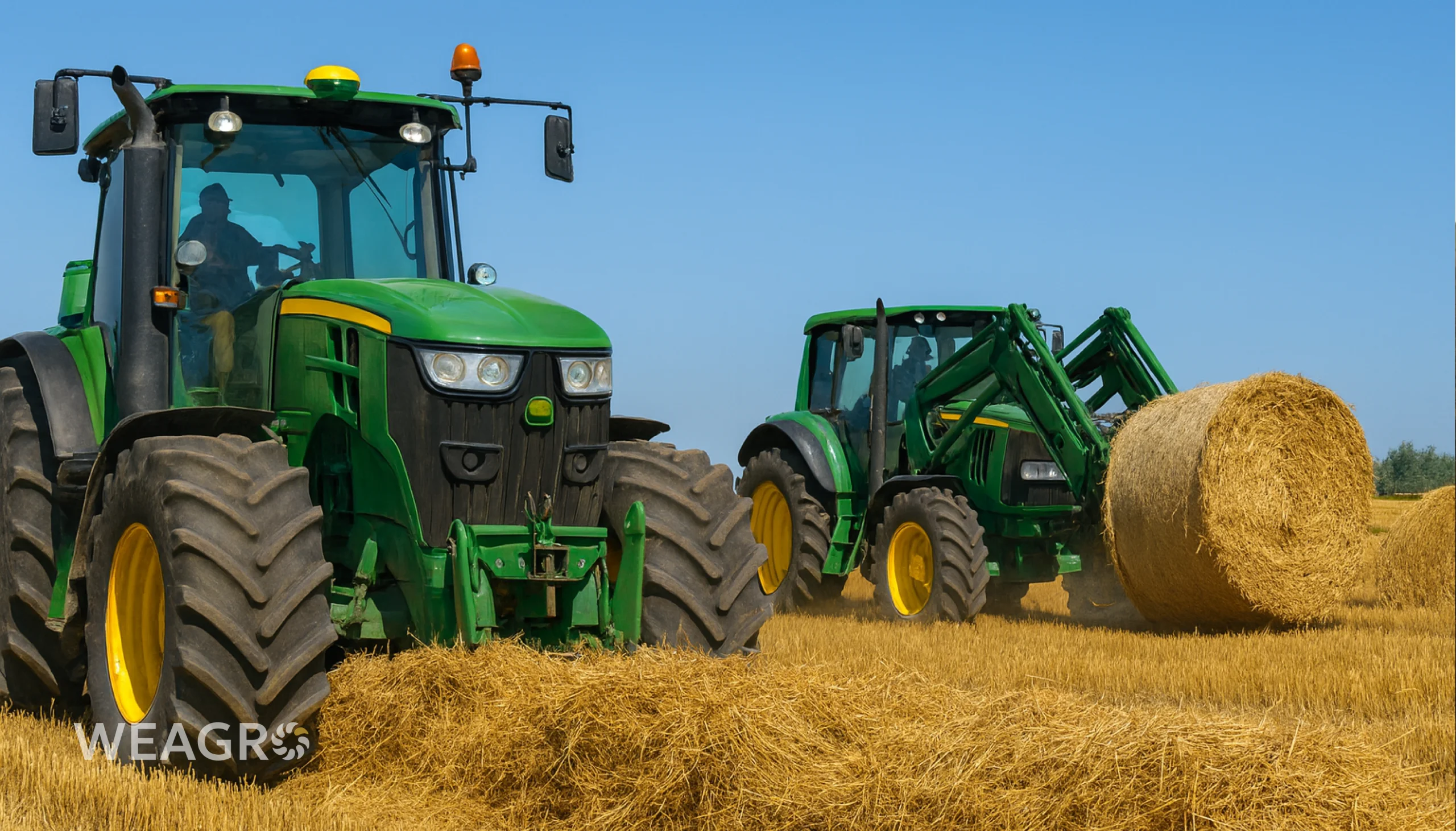The most essential and indispensable helpers for modern farmers are various types of tractors with specific characteristics and capabilities. They are used for various activities: from plowing to sowing, from mowing to harvesting. This powerful specialized equipment significantly increases the efficiency and productivity of agricultural work, while helping to optimize and accelerate operations. Some models are equipped with innovative technologies such as GPS navigation, monitors, displays, and audio systems, which improve ergonomics for drivers and task accuracy. An overview of key characteristics and advantages of popular equipment will help farmers make informed choices when selecting products for their specific farm.
Types of Tractors
Agricultural equipment is divided into types depending on purpose and functionality. Types of tractors are classified according to various criteria, such as:
- purpose;
- chassis type;
- power,
- frame construction.
Additionally, all types of tractors are divided by engine type into diesel, gasoline, and electric.
Classification by Purpose
Small and medium-sized farms use universal row-crop, general-purpose, and specialized tractors. General-purpose equipment is suitable for energy-intensive work:
- plowing difficult soils;
- cultivation;
- sowing;
- harvesting;
- transportation.
Some models are designed for earthmoving and loading operations. General characteristics of this group: power from 60 to 220 kW, speed 5-15 kilometers per hour, ground clearance range from 250 to 350 mm; tire or track size – averaging 400-500 mm.
Universal row-crop tractors of all types are used for cultivating row crops, plowing medium-light soils, harvesting grain and industrial crops, cultivation and harrowing, and other agricultural work. Key features: wide range of traction force – from 2 to 20 kN, working speed up to 15 km/h, and transport speed up to 35 km/h, power from 15 to 75 kW, turning radius up to 4 meters.
Specialized equipment includes various types of tractors that are modified according to specific conditions. For work in marshy areas, wide tracks are added to the base structure for better mobility, while models with horizontal frame positioning are used on mountain slopes.
Read also: How to register and deregister a tractor: procedure and necessary documents
Chassis Type and Frame Construction
Let’s examine the types of tractors by chassis type. Generally, they are divided into two major groups: wheeled and tracked. Wheeled varieties have front or all-wheel drive. The second option is more convenient as it increases the tractor’s mobility and maneuverability. This agricultural equipment is suitable for driving on asphalt surfaces and field roads. Its disadvantages include limited ground grip, which leads to slipping on wet and soft soil. Manufacturers offer 3-, 4-, 6-, and 8-wheeled models.
Tracked equipment offers better mobility and less slippage. Steel tracks are used for heavy work on difficult soils, while rubber tracks ensure reduced pressure on road surfaces.
Tractors are classified by various parameters, including frame type. The equipment is divided into these types:
- framed;
- frameless;
- semi-framed.
Understanding which tractor belongs to the framed category is very simple – such varieties have a rigid frame to which other parts, components, and mechanisms are attached. This frame ensures high strength and stability of the entire structure. In semi-framed models, part of the load is transferred to components (such as transmission) that simultaneously serve as the frame. In frameless models, main components such as the engine, transmission, and rear axle are directly connected to each other and form a single structure. This design reduces equipment weight and cost but requires high precision during tractor assembly.
Tractor Power
Several categories of equipment are distinguished by maximum traction power:
- small-sized (20-30 HP) – suitable for light agricultural tasks, gardening, viticulture, and greenhouses;
- medium-sized (30-70 HP) – used for most agricultural work, including plowing, mowing, and spraying;
- large-sized (70-150 HP) – used for processing (e.g., plowing) large territories, towing heavy machines, cultivation, harrowing, and sowing;
- high-powered (150-300 HP) – designed for performing the heaviest large-scale field work on large areas.
Purchasing any new tractor involves significant expenses for farmers. The online service WEAGRO offers the opportunity to use deferred payment by concluding a purchase agreement with the supplier. Our agricultural installment plan allows you to receive material and technical resources when needed and pay in installments over 180 days.
Which Tractor to Buy
Heavy equipment manufacturers regularly update their product range and modernize existing models. Most brands produce both tracked and wheeled products in various configurations and parameters. Many farmers consider the question – which tractor to choose for their farm. The answer depends on several factors, namely:
- territory size;
- soil types;
- types of work;
- optimal budget.
The decision on which tractor to buy is directly based on its intended purpose. Usually, for processing medium-sized agricultural plots, models with 30-70 HP are chosen, which handle not only field work but also harvesting and crop transportation. We advise how to choose a tractor considering these main conditions:
- Engine power – choose a unit with optimal power for your needs.
- Maintenance costs – before choosing a tractor, inquire about spare parts costs and availability of service centers in your location.
- Comfort and ergonomics – pay attention to operator cabin comfort, climate control availability, and other options.
- Modern functionality – choose models with GPS navigation, autopilot, and other current technologies.
- Manufacturer reputation – review feedback from other buyers: farmers and machine operators.
Before purchasing, be sure to test several models, consult with experts and colleagues on which tractor to choose for specific tasks.
Read also: Garden and Field Sprayers: Types, Operating Features
Which Tractors are Available to Ukrainian Farmers
Ukrainian farmers use functional types of tractors for quick and quality processing of medium and large plots, as well as for other agricultural work. Thanks to installment plans from the WEAGRO online service, farmers have access to a wide range of equipment, both domestic and foreign-made.
Foreign-Made Tractors
In 2023, Ukraine imported tractor equipment worth approximately 830 million dollars. Equipment from CNH (New Holland, Case IH) and AGCO corporations was in demand. CNH products account for over 30% of foreign supplies, particularly Case IH leads in models with 500+ HP, while New Holland dominates in the 250 HP category. Chinese manufacturers dominate in the low-power tractor segment up to 50 HP.
John Deere brand units are undisputed leaders in consumer preferences, having conquered the market with their reliability and versatility. In demand are: the 5ML narrow-track series, modernized 6R line, and improved 7R models. The 7R tractors this year were equipped with an innovative steering system that freely self-centers and maintains the set course well. 5ML is offered in two track width versions: standard and 1.55 meters. All John Deere equipment comes with a wide range of options for effective farming.
Another popular manufacturer is New Holland with its reliable T4, T5, T6 tractors and modern T7 and T9. The T7.300 unit has an extended wheelbase, thus guaranteeing more power without losing maneuverability. Another advantage is the electronic variable geometry turbine, which significantly saves fuel at low revolutions. The updated T9 series provides better productivity through increased power and modernized cursor engine. Small models 470, 520, and 580 are equipped with electronic turbocharger, while massive units 615, 655, and 700 with double width have two-stage turbocharging, which also increases their power.
Case IH’s highly efficient equipment deserves attention. The Quadtrac series features four tracks with independent full drives, ensuring even load distribution and long-term operation. Also, for time savings and increased task execution speed, they are equipped with the AFS precision farming system. The articulated Steiger line units have an improved functional cabin with indicators, terminals, and LED lighting.
Basak brand equipment offers optimal price-to-quality ratio, so farmers get quite good technical components and neat appearance at an acceptable cost. Power varies from 48 HP in miniature 2047 Eco Plus to 116 HP in the 5120 series.
When deciding which tractor to buy, many farmers consider practical and versatile YTO. These units are low-maintenance, reliable, economical, and produce high traction force with moderate fuel consumption.
Which Tractors Ukraine Produces
Before early 2022, several dozen enterprises in Ukraine manufactured agricultural equipment, including tractors. The state of war has made its adjustments, and the production capabilities of domestic brands have significantly decreased. This situation is affected by many factors: occupation of factories, destruction of buildings, lack of specialists, water, electricity supply, and other resources. Despite difficult conditions, as of 2024, Ukraine produces some types of tractors that are in demand among farmers:
- Agromashininvest, Dnipro: Farmer 10286;
- KhTZ, Kharkiv: wheeled models 248 and 249;
- DTZ, Dnipro: mini tractors with power 24-50 HP;
- Ukravtozapchastyna, Kyiv: KYI equipment.
More detailed information about which tractors are currently produced in Ukraine can be found on the official websites of these enterprises.
Conclusion
The challenges facing Ukrainian farming enterprises require the use of modern reliable equipment. Most farmers focus on tractor multifunctionality, while using specialized models for specific tasks. The online service WEAGRO can help reduce financial burden, offering the opportunity to quickly, conveniently, and without overpayment purchase products with deferred payment. Among those who have already used agricultural installments from WEAGRO are both farmers with 300-500 hectares of land and nationwide enterprises.









